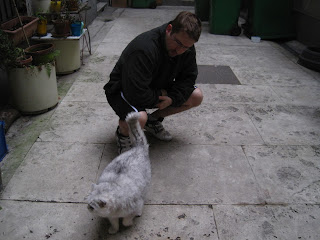When our friend, who had planned our Fontainebleau visit, came down with a serious case of French cheese upset stomach the morning of our departure, we wished her best, and decided to go ahead and make the journey out to Fontainebleau for the day.
With Normandy apple cider, baguette, three cheese, fruit salad, and of course cornichons, we made our way to Gare du Nord and from there to Fontainebleau, only a hour train ride from Paris.
Haven't heard of Fontainebleau? Not everyone has. The chateaux and its immense grounds remain a shadow aside the grandeur and splendor of Versailles. But that is not to discount the historical as well as visual grandeur of Fontainebleau. While not screamingly decadent and overtly aristocratic from initial glance, Fontainebleau's layers of history and charm reveal subtle and sophisticated decadence, rivaling, and in my opinion, out-doing, the overt and stand-offish grandeur of Versailles.
But it is not only the chateau that makes the trek out to Fontainebleau worth a visit. As a palace most notably used by the aristocracy for its surrounding hunting grounds. Fontainebleau boasts expansive and lush forests, with hiking trails and rock climbing available. Many people go out to Fontainebleau just to hike. I can attest to this; many of the people surrounding on the train were wearing heavy duty hiking boots and sports jackets. Even before arriving at Fontainebleau, the train stopped in the middle of the forest--no stop, no sign--just to let people out into the forest.
In addition to the forests, Fontainebleau remains a lively small self sustaining town, with small restaurants and markets just outside the chateau walls. Craving the potato chips we left on the counter at home, I convinced John to walk into town, with hope of finding a grocery store open to buy some barbecue chips. Yes we found the chips, but more importantly, we found a bustling Sunday morning farmers' market. We were convinced that the town would close up on Sunday, like Paris and many other towns of France. We could not be more wrong. Everything seemed to be open, and everyone seemed to be at this market.
Fresh poultry, fish, and cheese drew crowds and lines. Charcutterie, fresh fruit, and fresh produce drew the eye as well. If you wanted something, you could find it, from fresh bouquets of tulips to local honey to local wines. So a note to any of you thinking of going to Fontainebleau: go on a Sunday, take nothing with you, and buy your picnic at the market, it is worth the experience in and of itself.
Alas, we unfortunately had everything we needed for our warm day of picnicking, so we headed back to the chateau grounds, in search of a place to sit. The unique and worth visiting aspect of Fontainebleau is the ability to picnic on the chateau grounds. However, the chateau is still in France, and like many French manicured gardens, the line of where one can and cannot picnic remain clearly marked and enforced. Well clearly marked according to the man with a whistle on his bike, who forced us to move to a new location twice after laying out our whole picnic, even when there was a lack of signs. Despite the frustration, found a spot along the moat, like all other families. The scene looked eerily like two of Seurats most famous paintings. More than eery, it made me feel French. Like everyone else on that lawn, we sat there, drinking our cider, eating our menagerie, and soaking the all too rare warmth of the sun.
 |
| Our final destination Remind anyone of this patinting? : |
Two hours and a sunburn later, we trekked our way over to the chateau to take a look inside. As the most preserved chateau in all of France, I was surprised at how little of a footprint it made in historical must sees for Americans (at least it was never mentioned in my wanderings). Built in the 12th century and inhabited until the until the 19th century with the fall of Napoleon (1870), Fontainebleau remained the residence of all the major kings of French history, including Napoleon.
The chateau is also the most preserved chateau in France: most of the furniture is from the time, and very little if anything has been destroyed or removed. Due to the multiple royal families living in the chateau (yes Marie Antoinette as well), the chateau's interior reflects the changes in style and power from family to family, providing a fascinating look at the evolution of French aristocracy and the government beyond aristocracy. Do not be dissuaded by the less than glamorous exterior; the interior is well worth a visit, and I highly recommend the very interesting self guided audio tour available with the purchase of the ticket.
I will not bore you with the details of each room. Rather, the following are pictures of the some of the rooms I found most interesting and most jaw dropping in splendor. The history behind each room can be found in the commentary below the pictures. Again the photos do not do it just ice, you must go for yourself.
 |
| The Pope's Bedchamber (Apartment) Only the bedroom actually of the whole of the Pope's apartment. Yes, it looks grander than this in person. |
 |
| Trinity Chapel The royal entrance to the Chapel, from the second flour (only aristocracy had access to this entrance). |
 |
| Enter, Francois I Gallery. |
 |
| The Salamander: the symbolic animal of Francois I, decorating his gallery. The salamander is resistant to fire. |
 |
| The King's Bedchamber (Apartment) (The picture does not do it justice) |
 |
| Throne Room The last remaining throne room in France. A number of kings were thrones here. |
 |
| Trinity Chapel: Public Access Point |
 |
| The walk back to the train station. Yes that is us, we were there that long. |







































